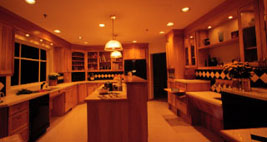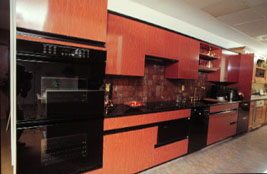Modern kitchens are more than a place to set the microwave
by Christian Moody

The real-life kitchen is designed for persons with disabilities.
It has a sink and a range that can be lowered. (B. Veltri)
by Christian Moody

The real-life kitchen is designed for persons with disabilities.
It has a sink and a range that can be lowered. (B. Veltri)
hink of your kitchen. Imagine it. Contemplate it for a minute. Why is it laid out the way it is? Who determined where the appliances are located? Their color? Who decided that the sink would have one basin instead of two?
The answers, it turns out, could be fellow Hokies -- Hokies who learned about interior design while taking classes in the College of Human Resources' Department of Near Environments.
Because the kitchen is such an integral part of any residence, Tech recently installed a lab with five kitchens, representing five different styles.
Personally, I never gave kitchen design much thought. Every place I ever lived had a kitchen, with the exception of Pritchard Hall, but I had to take them as offered. The ochre color of the appliances in Foxridge during college. The unobtrusive white of the range and refrigerator in the apartment I live in now. Kitchens are like a bank statement to me -- somebody else figures it out; I accept the results.
So with the idea of seeing new concepts in design, I went to Wallace Hall for the unveiling of the new Center for Real Life Kitchen Design, which opened Sept. 24. Sure, I knew each kitchen is subtly different, but I had no idea the amount of thought that went into them. Of the five kitchens in the center, the gourmet kitchen was the one in which I would never feel comfortable. It was designed for people preparing large meals, for many guests. More than three people in my apartment at once makes me nervous the neighbors are going to call the police about noise. The stove and refrigerator had cold, stainless steel fronts. They were large enough to store and prepare meals for a high school reunion, and they were designed for people who are serious about their kitchens. I am not one of those people.
I have a range that has been on at least twice in the 10 months I've lived there, but I'm not sure about the oven. I vaguely remember eating a frozen pizza, so I must have used the oven. Frozen pizzas are not good microwave food.
 |
The contemporary kitchen was designed for entertaining. It was a yuppie showpiece of style, with ostentatious functionality. There was even a warming drawer, where meals are kept if you would need to prepare them in advance, then keep them warm through the salad course. I don't entertain like that either. The last guest who ate in my home heated a convenience store burrito in the microwave in the wee hours of the morning. That would violate a zoning ordinance in the contemporary kitchen. |
|
|
The starter kitchen was small, like you would expect in a starter home. But it had two microwaves. Now that is a novel concept. With two microwaves, I could have soup and a frozen dinner during the same meal -- and they would be ready at the same time. I liked the premise.
When I was looking through the family kitchen I noticed something different. Some cabinets had no doors. They were basically just shelves. That looks good in theory. The plates, neatly stacked, are inoffensive. The glasses are nearby, not hidden, and ready to grab. Little wicker baskets with devil's ivy, real or plastic, work well. Neat concept, but it couldn't work for me. What happens on the shelf that also doubles as a medicine cabinet? It could look a little tacky having a large collection of assorted pain relief medications and antacids on display for all to see. And what about all the plastic stadium cups I prefer, but I have been told are also just this side of sophisticated? Where are they to be hidden? I think I need cabinet doors, myself.
The last kitchen was a marvel. It is one for real-life design, meaning it was designed for people who have disabilities. The sink and the range were adjustable, so they could be lowered and used by a person in a wheelchair. There was a ridge on the counter top to assist persons with visual challenges. Since most people who are legally blind can still see some light, the linoleum on the floor had a dark and light contrasting pattern specifically set to allow those folks to know where the cabinets are. I admire whomever thought of that.
That kitchen would not work for me, either, because the stove was in the center countertop. I would burn my house down because the countertop in my house is used primarily as a receptacle for unopened mail. Mail that looks vaguely important, so I might open it someday. It collects, waiting for the day I know will never come, but effectively shields the counter from the buildup of dust.
The kitchen center amazed me. It almost inspired me to learn more about the workings of my own kitchen. My appliances are ergonomically located close together to facilitate their use, I found out. And here I just thought I had a small kitchen. Actually, I like my small kitchen. I think in the larger ones I would be completely useless.
Well, maybe not entirely useless, I can operate a refrigerator, and microwaves can handle anything but frozen pizza, right?
Home | News | Features | Research | Philanthropy | President's Message | Alumni | Classnotes | Editor's Page